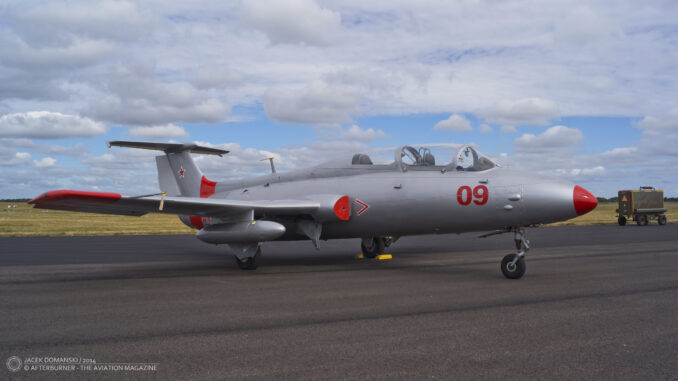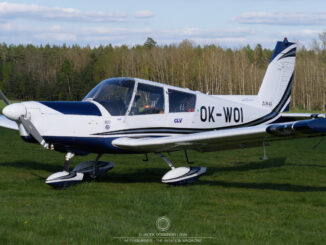
Aero L-29 Delfín (Dolphin, NATO reporting name: Maya), c/n 394952, on apron of Karup air force base, Danish Air Show, June 2014.
Behind creation of L-29 Delfín there was a sum of several favouring factors. A demand for dedicated training aircraft appeared within the air forces of the Warsaw Pact countries, as a direct consequence of sustainable development of jet-powered military aviation. At the end of the 1950s a few Eastern Bloc countries already issued official requirements for such trainer that were noticed and responded by local aviation manufacturers. This has resulted in a few studies and projects, four of which have reached the prototype stage: Aero L-29 Delfín in Czechoslovakia, TS-11 Iskra in Poland, Yakovlev Yak-30 in the Soviet Union and SOKO G-2 Galeb in Yugoslavia.
The Soviet Union leaders have gone a step further – in the process of searching a jet trainer for the Soviet Air Force it was also decided that such aircraft should be selected as the standard training aeroplane for all Warsaw Pact countries.
Aero construction team, led by Z. Rublič and K. Tomáš, proposed a simplistic construction with unswept wings, T-shaped tail and air intakes at the wing roots. Interestingly, such design was not so different from other trainers, already mentioned above. The prototype of Delfín, designated XL-29, performed its maiden flight on 5th April 1959.
Starting 1960, prototypes of TS-11, L-29 and Yak-30 were evaluated as the potential standard training jet for air forces of the Warsaw Pact countries (G-2 was, for obvious political reasons, excluded from this competition). Although during flying tests and further evaluation all pointed to TS-11 as a winner of Warsaw Pact trainer contest, the final results were somehow surprising and in 1961 the L-29 Delfín was announced the winner.
Regrettably, the exact reason behind such result of the competition is unclear. Aviation historians and enthusiasts were discussing this matter over years; however the results are still inconclusive.
Nevertheless, victory in the contest secured the commercial success of L-29. Serial production of Delfín was launched in 1963 and more than 3,600 aircraft were built. The Czechoslovak trainer was used not only by the Soviet Air Force and air forces of other Warsaw Pact countries, but also served in Afghanistan, Egypt, Ghana, Indonesia, Mali, Nigeria, Uganda, Vietnam and other Eastern Bloc countries. Production of L-29 was ceased in 1974, as a result of introduction of its successor, Aero L-39 Albatros.
It should be also mentioned that Poland did not adopt L-29 as military training aircraft and continued with development of the TS-11 that became operational in 1964 and was operated by the Polish Air Force until 2020. Yugoslavia, which was not a Warsaw Pact member, stayed with its own construction and SOKO G-2 was officially introduced in 1965. The Galeb was manufactured until 1985, almost 250 aircraft were built and operated by Yugoslav and Libyan air forces, single aeroplanes were acquired by Zambia, Zaire and Indonesia. Further development of the Yak-30 was abandoned.
Several L-29s survived until today and are still being used by civilian operators all over the world. The Delfín pictured above was manufactured in 1973 and initially operated by the Soviet Air Force. After a collapse of the Soviet Union, it was stored in Estonia until 1999 and then sold to private owners. In 2003 it was bought by Danish operator and registered as OY-LSD.



